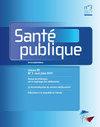Accompagner l’applicabilité et la transférabilité du programme « Sortir Ensemble & Se Respecter » en Frances
IF 0.3
4区 医学
Q4 PUBLIC, ENVIRONMENTAL & OCCUPATIONAL HEALTH
引用次数: 1
Abstract
INTRODUCTION The prevention of intimate partner violence (IPV) among young people is a major challenge for public policies. Nevertheless, there are a few prevention programs that have proven effective in France. “Sortir Ensemble & Se Respecter” (SE&SR) is a Swiss adaptation of “Safe Dates,” an American intervention program that has reduced violent behavior by young perpetrators and victims of IPV alike. The aim of this article is to analyze the applicability and “potential transferability” of SE&SR in France. METHODS We described the SE&SR intervention by explaining the intervention theory, the key functions (i.e., the “ingredients” allowing the SE&SR program to work), and we commented on its applicability from a perspective of adapting and transferring it to the French context. We used the ASTAIRE tool and the FIC (key functions, implementation, context) approach. RESULTS The intervention theory highlighted various factors, acting at the individual level (i.e., beliefs/representations, knowledge, life skills) and at the level of the living environment (i.e., facilities welcoming young people; families; public policies; networks of actors), that can prevent IPV among young people. Ten key functions have been identified, revealing the “skeleton” of the Swiss intervention. We drew on these results to comment on the intervention’s applicability, with a view to transferability, specifying the contextual elements to consider before implementing SE&SR in France. CONCLUSION This study aims to make the process of evaluating applicability, with a view to transferring an evidence-based program to the French context, more accessible.支持 "共同排序与尊重 "计划在法国的应用和推广
引言 预防青少年亲密伴侣间的暴力行为(IPV)是公共政策面临的一项重大挑战。然而,在法国,有一些预防计划被证明是有效的。"Sortir Ensemble & Se Respecter"(SE&SR)是瑞士对美国干预项目 "安全约会"(Safe Dates)的改编,该项目减少了亲密伴侣间暴力行为的施暴者和受害者。本文旨在分析 SE&SR 在法国的适用性和 "潜在可移植性"。我们通过解释干预理论、关键功能(即 SE&SR 项目发挥作用的 "要素")来描述 SE&SR 干预,并从将其改编和移植到法国环境的角度对其适用性进行了评论。我们使用了 ASTAIRE 工具和 FIC(关键功能、实施、背景)方法。结果干预理论强调了在个人层面(即信仰/代表、知识、生活技能)和生活环境层面(即欢迎年轻人的设施、家庭、公共政策、参与者网络)发挥作用的各种因素,这些因素可以预防年轻人之间的 IPV。我们确定了十项关键功能,揭示了瑞士干预措施的 "骨架"。我们利用这些结果对干预措施的适用性进行了评论,以期实现可移植性,并明确了在法国实施 SE&SR 之前需要考虑的背景因素。
本文章由计算机程序翻译,如有差异,请以英文原文为准。
求助全文
约1分钟内获得全文
求助全文
来源期刊

Sante Publique
PUBLIC, ENVIRONMENTAL & OCCUPATIONAL HEALTH-
CiteScore
0.40
自引率
33.30%
发文量
252
审稿时长
>12 weeks
期刊介绍:
La revue Santé Publique s’adresse à l’ensemble des acteurs de santé publique qu’ils soient décideurs,
professionnels de santé, acteurs de terrain, chercheurs, enseignants ou formateurs, etc. Elle publie
des travaux de recherche, des évaluations, des analyses d’action, des réflexions sur des interventions
de santé, des opinions, relevant des champs de la santé publique et de l’analyse des services de
soins, des sciences sociales et de l’action sociale.
Santé publique est une revue à comité de lecture, multidisciplinaire et généraliste, qui publie sur
l’ensemble des thèmes de la santé publique parmi lesquels : accès et recours aux soins, déterminants
et inégalités sociales de santé, prévention, éducation pour la santé, promotion de la santé,
organisation des soins, environnement, formation des professionnels de santé, nutrition, politiques
de santé, pratiques professionnelles, qualité des soins, gestion des risques sanitaires, représentation
et santé perçue, santé scolaire, santé et travail, systèmes de santé, systèmes d’information, veille
sanitaire, déterminants de la consommation de soins, organisation et économie des différents
secteurs de production de soins (hôpital, médicament, etc.), évaluation médico-économique
d’activités de soins ou de prévention et de programmes de santé, planification des ressources,
politiques de régulation et de financement, etc
 求助内容:
求助内容: 应助结果提醒方式:
应助结果提醒方式:


